Hanover Bald Eagle Blog # 9 - 2022
In partnership with Pennsylvania Game Commission and Comcast Business .
Throughout their range, bald eagles are known as fish specialists. Although fish do make up over 50% of their diet, they also eat birds, mammals, and dead animals called carrion. Bald eagles take advantage of food where they can find it, demonstrating opportunistic feeding behavior. They are scrappy scavengers. In fact, it’s common to see bald eagles and turkey vulture dueling for entrails.
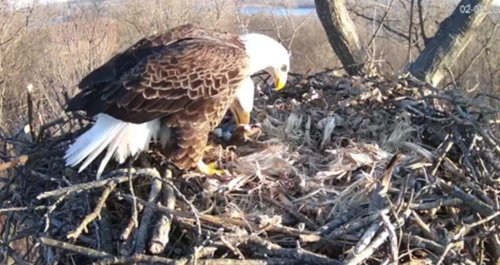
This flexibility makes bald eagles extremely effective predators. They are capable of displacing most other avian scavengers such as magpies, crows, ravens, and vultures, all of whom observe other species closely in order to locate food. For example, in the Pacific Northwest I have watched bald eagles arrive on the scene of a killer whale hunt and grab leftover pieces of seal and porpoise. Researchers in B.C. have witnessed eagles following salmon-eating killer whales as well. In September, in the same region, large numbers of bald eagles depart to take advantage of adult salmon at the end of their spawning journey. The eagles remember where the spawning grounds are and when the salmon will be there. In Maine, I have seen hundreds of eagles clustered outside of butcher shops.
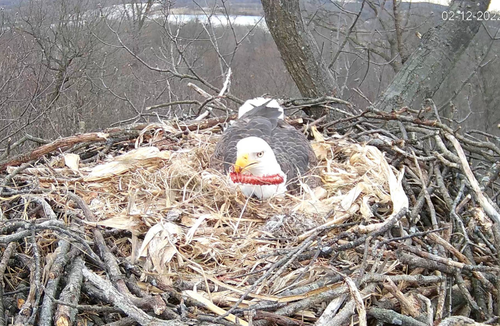
Morning leftovers in the Hanover nest, a spine from the previous night's meal.
As opportunists, they know when to get creative.
In Pennsylvania, bald eagles rely on carrion most heavily during the winter, when bodies of water may ice over and other food sources such as waterfowl and small mammals either migrate or seek refuge from the cold. When food is scarce, competition increases, and some individual eagles move to seek more promising buffets.
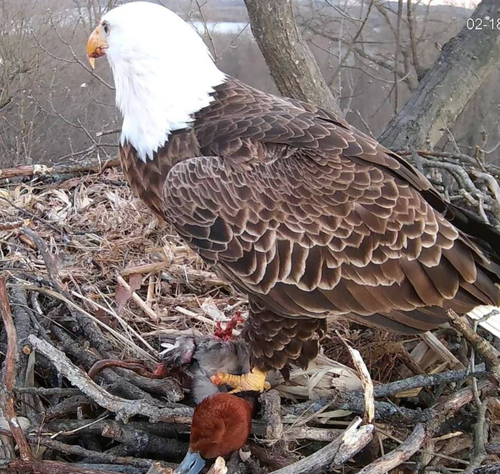
In a study conducted in 1987, five foraging methods were identified for bald eagles: hunting in flight, hunting from a perch, hunting on the ground, hunting cooperatively, and wading in the water. In The Bald Eagle: Haunts and Habits of a Wilderness Monarch (1988), Gerrard and Bortolotti describe several fascinating accounts of cooperative hunting in bald eagles including: a mated pair working together to hunt snow geese in Louisiana in the 1890’s, another pair hunting cattle egrets in Florida, and eagles in Utah working together to flush and kill black-tailed jackrabbits!

“I have observed eagles to land and then walk along the ground through low brush in what appears to be deliberate attempts to flush prey. This method appears quite successful because airborne birds indicate by their activities that they see prey and kills [are] subsequently made.”
-Clyde Edwards, from Bald Eagle: Haunts and Habits of a Wilderness Monarch
Not all eagles feed alike. Besides individual variation, age is also a factor in how efficient an eagle is at capturing food and even what they feed on. It takes young eagles a long time to become successful hunters. Therefore, they often take advantage of the easiest, least desirable food until they gain more advanced skills.
Taken as a whole, we can see that the feeding habits of bald eagles are remarkably diverse and flexible depending on what food is available, where the eagles live, their age, and even individual skillsets. Their cunning strategy for acquiring food makes bald eagles one of the most rewarding members of the wildlife community to observe. There are few sights as potent as a bald eagle with blood on its beak and that unique look in its eye, reminding us all of their inherent and beautiful wildness.
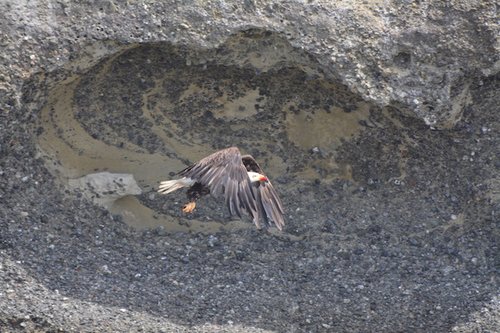
Eagle in Flight After Feeding Event. Photo: Zoey Greenberg
Fun Facts
-I once saw a turkey vulture sneak up behind a bald eagle and steal a large piece of seal from right between the eagle’s legs!
-Bald eagles consume roughly 5-10% of their ow weight every day.
-Dead fish are more often taken by bald eagles than live ones. When floating belly up the fish flash white or sliver, making them more easily detectable by eagles than live fish.
-Catfish are a common prey item for bald eagles, perhaps because they have downward focused eyeballs and limited reactions to what’s approaching from above.
-Eagles are known to steal food from more successful fishing birds like osprey and great blue herons. This behavior is called “food piracy.”
-Bald eagles have a crop (an enlargement of the esophagus) which allows them to gorge themselves on more carrion than their stomach can immediately process. They digest the excess food later.
Sources
Gerrard, Jonathan M., and Bortolotti, Gary R. (1988). The Bald Eagle : Haunts and Habits of a Wilderness Monarch. Smithsonian Institution Press.
Greenberg, Zoey (2029). Bald Eagle Feeding Behavior. HDOnTap.
https://hdontap.com/index.php/articles/article/hanover-bald-eagle-blog-6
John, Kate St. (2022). Nesting: Why are the eggs red? Outside My Window.
https://bit.ly/3sOSHjf
Ofelt, C. H. (1976). Unusual Feeding Behavior of Bald Eagles in British Columbia. The Murrelet, 57(3), 70–70. http://www.jstor.org/stable/3536251
Last Week’s Answer:
Peregrine falcon eggs are thought to be red because this offers them camouflage, which they need, because peregrine parents don’t start incubating until the third egg is laid. Red pigment is called protoporphyrin, and it has been correlated with eggshell strength. Some peregrine eggs are a creamy color with red splotches. In songbird studies, red splotches showed up where the eggshell was thinnest. Whether this pigmentation-to-strengthen strategy is used by peregrine females, no one knows, but the variation is peregrine eggs is certainly thought-provoking.
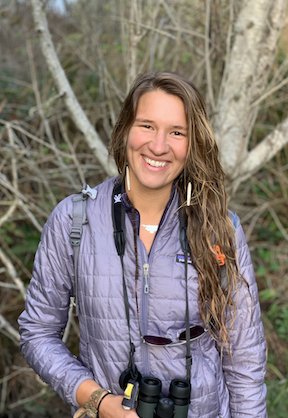
RETURN TO HANOVER BALD EAGLE BLOGS
WATCH THE HANOVER BALD EAGLE LIVE CAMS
For over 20 years, HDOnTap has provided live streaming solutions to resorts, amusement parks, wildlife refuges and more. In addition to maintaining a network of over 400 live webcams, HDOnTap specializes in design and installation of remote, off-grid and otherwise challenging live streaming solutions. Contact press@hdontap.com for all media needs, including images and recordings.